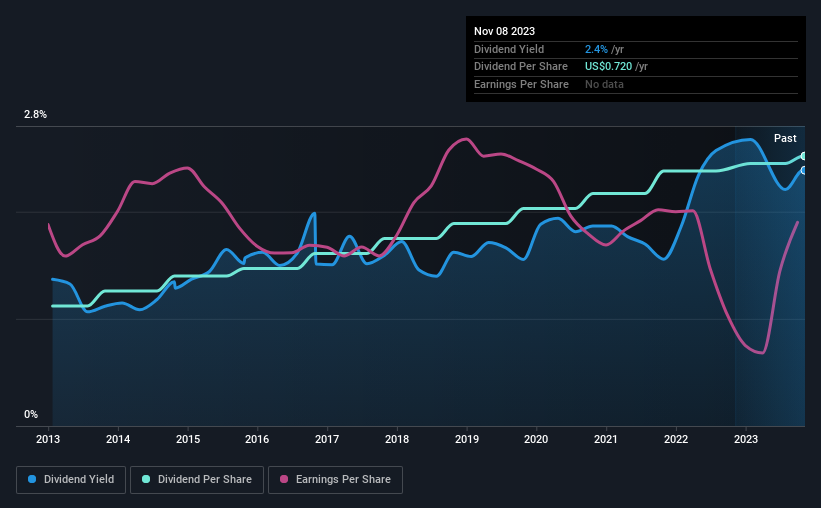Interested In Gorman-Rupp's (NYSE:GRC) Upcoming US$0.18 Dividend? You Have Four Days Left
Some investors rely on dividends for growing their wealth, and if you're one of those dividend sleuths, you might be intrigued to know that The Gorman-Rupp Company (NYSE:GRC) is about to go ex-dividend in just 4 days. Typically, the ex-dividend date is one business day before the record date which is the date on which a company determines the shareholders eligible to receive a dividend. The ex-dividend date is important as the process of settlement involves two full business days. So if you miss that date, you would not show up on the company's books on the record date. In other words, investors can purchase Gorman-Rupp's shares before the 14th of November in order to be eligible for the dividend, which will be paid on the 8th of December.
The company's upcoming dividend is US$0.18 a share, following on from the last 12 months, when the company distributed a total of US$0.72 per share to shareholders. Based on the last year's worth of payments, Gorman-Rupp has a trailing yield of 2.4% on the current stock price of $30.16. If you buy this business for its dividend, you should have an idea of whether Gorman-Rupp's dividend is reliable and sustainable. We need to see whether the dividend is covered by earnings and if it's growing.
See our latest analysis for Gorman-Rupp
Dividends are typically paid out of company income, so if a company pays out more than it earned, its dividend is usually at a higher risk of being cut. Gorman-Rupp paid out more than half (64%) of its earnings last year, which is a regular payout ratio for most companies. Yet cash flows are even more important than profits for assessing a dividend, so we need to see if the company generated enough cash to pay its distribution. Fortunately, it paid out only 37% of its free cash flow in the past year.
It's positive to see that Gorman-Rupp's dividend is covered by both profits and cash flow, since this is generally a sign that the dividend is sustainable, and a lower payout ratio usually suggests a greater margin of safety before the dividend gets cut.
Click here to see the company's payout ratio, plus analyst estimates of its future dividends.
Have Earnings And Dividends Been Growing?
Companies that aren't growing their earnings can still be valuable, but it is even more important to assess the sustainability of the dividend if it looks like the company will struggle to grow. If business enters a downturn and the dividend is cut, the company could see its value fall precipitously. That explains why we're not overly excited about Gorman-Rupp's flat earnings over the past five years. We'd take that over an earnings decline any day, but in the long run, the best dividend stocks all grow their earnings per share. Earnings growth has been slim and the company is paying out more than half of its earnings. While there is some room to both increase the payout ratio and reinvest in the business, generally the higher a payout ratio goes, the lower a company's prospects for future growth.
Another key way to measure a company's dividend prospects is by measuring its historical rate of dividend growth. In the last 10 years, Gorman-Rupp has lifted its dividend by approximately 8.4% a year on average.
Final Takeaway
Has Gorman-Rupp got what it takes to maintain its dividend payments? Earnings per share have been flat and Gorman-Rupp's dividend payouts are within reasonable limits; without a sharp decline in earnings we feel that the dividend is likely somewhat sustainable. In summary, it's hard to get excited about Gorman-Rupp from a dividend perspective.
In light of that, while Gorman-Rupp has an appealing dividend, it's worth knowing the risks involved with this stock. Our analysis shows 1 warning sign for Gorman-Rupp and you should be aware of it before buying any shares.
A common investing mistake is buying the first interesting stock you see. Here you can find a full list of high-yield dividend stocks.
Have feedback on this article? Concerned about the content? Get in touch with us directly. Alternatively, email editorial-team (at) simplywallst.com.
This article by Simply Wall St is general in nature. We provide commentary based on historical data and analyst forecasts only using an unbiased methodology and our articles are not intended to be financial advice. It does not constitute a recommendation to buy or sell any stock, and does not take account of your objectives, or your financial situation. We aim to bring you long-term focused analysis driven by fundamental data. Note that our analysis may not factor in the latest price-sensitive company announcements or qualitative material. Simply Wall St has no position in any stocks mentioned.

